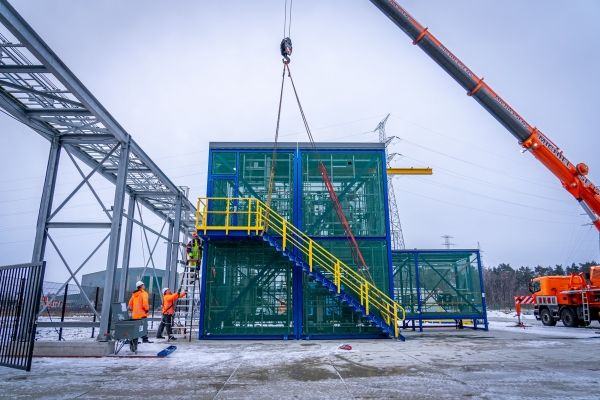iFLUX makes the transition to real-time digital groundwater monitoring
Since it was founded in 2017, iFLUX has been offering solutions for determining the dynamics of groundwater flow and pollution in the soil. It does so based on innovative measurement technology combined with a targeted data analysis. These identify the speed and direction of groundwater and the pollution it contains using flux measurements. Today, this is mainly analogue (the pollutant fluxes are determined in monitoring tubes through adsorption and recovery processes, from which the effective fluxes in the soil are then extrapolated), but the ability to do this digitally too (remotely and in real-time) is a recent development.
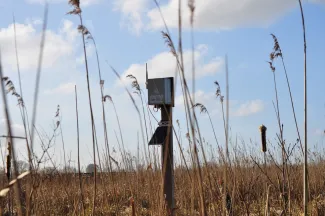
At the end of this year, iFLUX, a spin-off from VITO and the University of Antwerp, will be blowing out five candles. The start-up, which identifies soil pollution by monitoring groundwater, has seen strong growth in the past few years. The corona pandemic did temporarily curb its activities, however, particularly as regards opening up foreign markets.
That growth is continuing unabated today. The number of employees at iFLUX, which is headquartered at the University of Antwerp's Science Park in Niel, is set to almost double in the coming months. At the same time, the company is currently going through a major transition. This will shift its activities from more reactive monitoring based on analogue sampling technology for groundwater to a digital system that allows for real-time monitoring. It should enable customers to work preventatively on soil pollution, as well as on water issues more broadly.
We talked about the recent past and the near future with Tim Op ’t Eyndt and Goedele Verreydt. They call themselves iFLUX's co-CEOs – each with their own expertise, being commercial and scientific respectively.
Will the transition to a digital, real-time monitoring system have an impact on your customer base too?
Op ’t Eyndt: ‘That's the intention, yes. With the new system, which is based on self-developed sensor technology that measures continuously and in real-time, we're looking to open up and expand our customer potential. Our service provision will also include preventative solutions, alongside reactive ones where action is only taken once the soil pollution has been identified. We've been picking up market signals that there's a great need for this in the past few years. In doing so, we won't just be aiming at customers working in the soil remediation sector anymore, but at drinking water companies, project developers and agricultural firms too, for example. By combining various kinds of measurement data, we can provide insights to customers that weren't possible before. Thanks to this real-time information, they'll be able to respond to undesirable situations more quickly and even preventatively. That way, problems can be prevented and costs can be saved.’
Verreydt: ‘Authorities stand to benefit from our measurements too. Not only the ones focusing on soil pollution, but also the bodies working on structural water issues. Especially in Flanders, where far too little water still penetrates the soil, this issue is structural and urgent. Our monitoring based on measurements of the flow rate of the groundwater, for example, provides valuable insights into the water balance, the anticipated climate impact and the practical need to make areas wetter. This means we're also doing our bit for the Blue Duel, through which the Flemish government is aiming to restore the water system in our region.’
Op ’t Eyndt: ‘As it happens, we're seeing a range of climate-related market segments coming about these days. These include agricultural firms aiming to arm themselves against drought or construction firms that don't want to have the groundwater they pump up during the works carried off via the sewers anymore. Those customers all stand to benefit from solutions based on high-quality data. That's the only way they can improve their processes, monitor properly and adjust at the right moment.’
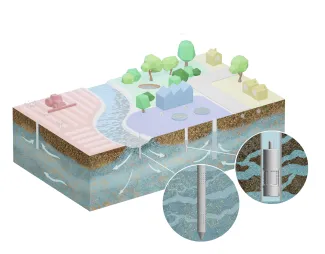
Soil pollution and water issues have been rising higher and higher up the agenda in the past few years, including abroad. Are you seeing a lot of competition yet?
Verreydt: ‘For now, what we do, which is effectively measuring the flows and fluxes of groundwater (or other watery substances) in situ, is unique. And once our digital measurement system is ready, we'll be the only global player in this offering something like that. But at the same time, we do realise that the market is rapidly developing and that similar players to ourselves will come along.’
Op ’t Eyndt: ‘There are two kinds of competition today. You've got the suppliers who sell off-the-shelf technology and don't get involved in giving the customer peace of mind, giving them only limited support in interpreting the measurement data. And you've got the consultants who mainly conduct a lot of studies into soil pollution and groundwater. The consultants' and technology suppliers' activities are far removed from one another. We're positioning ourselves in between with our digital service provision based on high-quality data. Our sense is that customers have a need for data-driven services that combine both sides of the spectrum. After all, data without interpretation doesn't give you any useful information.’
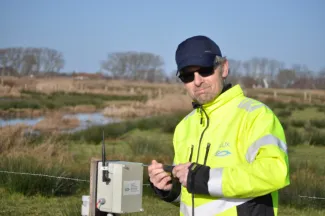
You are currently expanding massively. Are you managing to find the right people?
Op ’t Eyndt: ‘We're still a new company, a start-up, so we attract primarily entrepreneurial and ambitious people. Besides that, we're helping to write an engaging story, which we notice from our job applicants. Water issues and soil pollution are very pressing societal themes – the crisis around PFAS pollution in Zwijndrecht comes to mind.’
‘We're now working to double our team from eight to sixteen employees. We're looking for experts who can make the connection with our customers as IT people and data scientists who can carry out projects successfully. We can only do this thanks in part to a prestigious grant from the European Innovation Council (EIC), which we pulled in late last year. This ‘accelerator grant’ stimulates companies to be able to bring their unique technology and solutions to market more quickly. In our case, this involves the digital, real-time monitoring technology. Over the term of the grant (two years), we're aiming to digitalise our service provision further and reduce our distance to customers. We're quite proud of it: out of four thousand submissions from all across Europe, we were the only Belgian candidate selected by the EIC.’
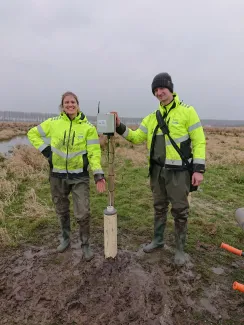
How is the internationalisation going? Has that resumed now the corona pandemic is over?
Op ’t Eyndt: ‘At present, our counter for projects we've helped work on is over a hundred. Forty percent of those were abroad. We mainly work within Europe, although we did have some recent projects in the Gulf Region and in the United States too. The foreign projects mainly involve remediating industrially polluted soils.’
Verreydt: ‘The advantage of our existing, analogue monitoring system is that it's rapidly scalable. That means we can outsource the fieldwork to specialists, such as the soil experts we often collaborate work. This makes our foreign activities easier, as we don't always have to go there ourselves. We're looking to develop a scalable solution for our digital sensor system in the short term too. The next thing to do is further refine the prototypes in our lab so as to end up with a successful demonstration and validation.’
More info: tim@ifluxsampling.com


